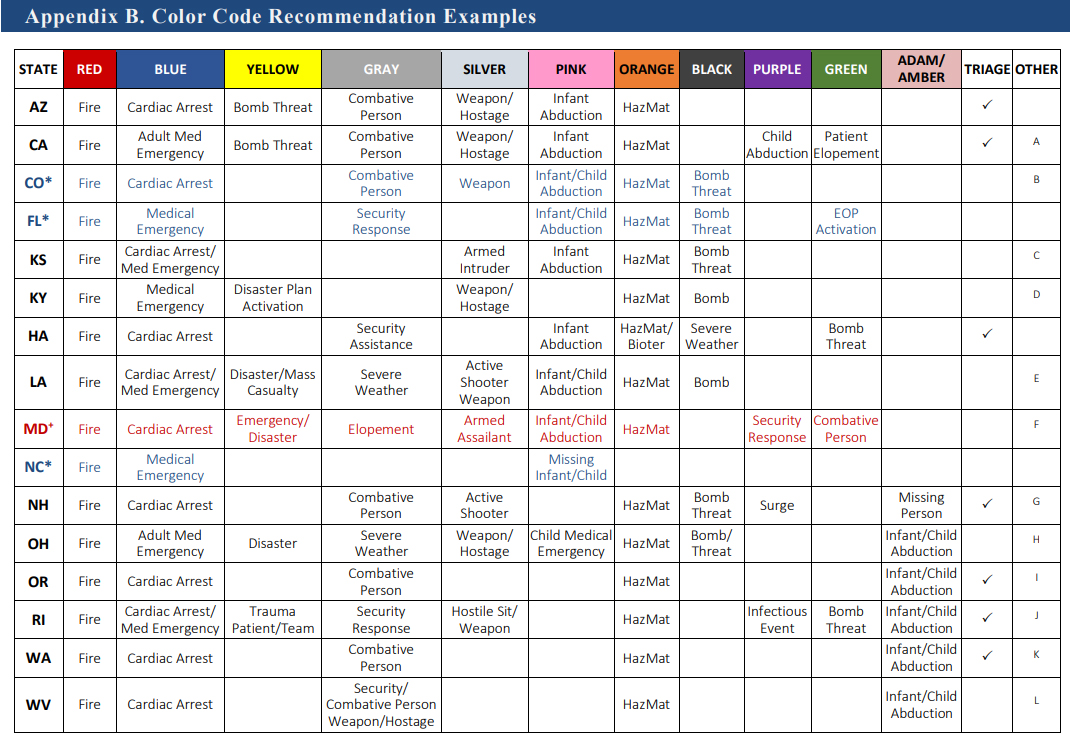Code Red Hospital Training: What You Need to Know
If you work in a hospital, code red may be part of your workday at some point. When these emergencies occur, you want to be as useful as possible in order to reduce the impact on the hospital, patients and visitors. For this reason, it is important to understand what this code means, as well as the proper response.
Code Red in Hospitals: What do hospital color codes mean?
What is the purpose of this code? Will it impact people who are staying at the hospital?
In this article, we will be explaining Code Red in hospitals. What is the meaning of this code? What should we do if we receive a code red alert? Knowing these procedures may help you stay safe.
Why is this code red so important in hospitals?
Hospitals would never be empty. It fills with patients, doctors, nursing staff, patients’ families, and cleaning staff.
Hospitals are where you will go if you become ill. Yet, unexpected emergencies could happen at any time, and people who are at the hospital should know how to manage the situation.
Earlier, in Tulsa, Oklahoma, a gunman killed himself and three other victims when he went on a rampage at the health center. He did it out of revenge against his doctor, who “caused him pain.”
This kind of incident shows how hospitals can come under attack. When hospital personnel is aware of the situation, they can implement safety measures, including some hospital codes.
The problem isn’t a shortage of people wanting to be doctors, but rather, too few opportunities for training. Medical schools have increased class sizes by 30% since 2002, but federal funding for residency training – an essential step in the process of becoming a practicing physician – has not increased since 1997, according to Inside Higher Ed.
When these sorts of incidents occur, the hospital administration and staff can follow instructions to safeguard themselves and people who are at the hospital using safety protocols that are referred to as “color codes.”
How does hospital staff respond when they hear Code Red?
This code indicates that when someone is in the hospital and sees fire or smoke, or anyone working in the hospital notices flame, they can declare Code Red.
In the next step, hospital staff can immediately shut the door, and people who are at the hospital should wait in the hall until further instructions.
How can we remember the guidelines for code red?
By using the acronym R.A.C.E., we can memorize the code red guidelines:
R stands for Rescue
A stands for Alarm
C stands for Close
E stands for Extinguisher
There are also other important hospital codes that you should know about since incidents can happen to you at any time and your life is at risk.
Some of the other codes include Code White, Code Blue, Code Orange, Code Yellow, Code Grey, Code Silver, Code Brown, Code Purple, and Code Clear.
Code Blue:
Code Blue is the most common one it uses when a patient is experiencing chest pain or is in cardiopulmonary arrest.
Code White:
If we talk about Code White, it is almost similar to Code Blue, which focused on child emergencies.
Code Orange:
It is used when we need a mass evacuation due to a leak of poisonous gas.
Code Yellow:
For bomb blast emergencies.
Code Grey:
Used for some kind of violent attack by any person.
Code Silver:
Used for an alleged active shooter in the hospital.
Code Brown:
Used when external chemicals spill.
Code Purple:
Used when a lockdown is being implemented.
Code Clear:
To inform people that the situation is under control.
So, a lot of danger could happen to us in the hospital. These hospital color codes can save us from any possible danger if we follow them correctly.
In primary schools and colleges, we can also teach the children about these codes, which can help students who want to pursue a career in the medical profession; however, these codes can also be advertised on television channels or radio channels for public awareness.
Are HOSPITAL codes following all over the world?
Many hospitals in the world use simple language or plain language to define emergency notifications. There is some confusion among the hospital staff and people about the code words, but some thought that it would be helpful for those being treated to be aware of an emergency situation so that they could respond appropriately.
Plain language is still not used more frequently than color codes, but many hospitals are moving in this direction to increase public safety.
In many countries, hospital associations are making improvements to increase the standardization of emergency communication at hospitals. A more consistent system of emergency alerts could improve public safety.
Ausoma is one of the most prominent medical colleges for students in the field of medicine and teaches its students about medical terminologies. Every year, students graduate from this institution and begin working in various hospitals across the United States.
Code Red Hospital Training: What You Need to Know
If you work in a hospital, code red may be part of your workday at some point. When these emergencies occur, you want to be as useful as possible in order to reduce the impact on the hospital, patients and visitors. For this reason, it is important to understand what this code means, as well as the proper response.
What Is a Code Red?
A code red is announced when there is reason to believe that a fire emergency is present within the building. For example, a staff member or visitor to the hospital may see smoke, smell smoke or see flames. Someone may also report a possible fire if doors or walls in the hospital feel hot when touched.
We offer Online ACLS, PALS and BLS Certification and Renewal
Typically, the code red will be announced within a specific location to let responders know where the threat is suspected. For example, the announcer may say “code red ER” or “code red surgery unit.” If the hospital has the appropriate technology, staff members may even receive an alert on their phones or other mobile devices before the announcement is made throughout the hospital.
What Do Staff Members Do During a Code Red?
During a code red, hospital staff will have different responsibilities depending on their position. Some members of the staff will be working to move patients who are vulnerable to the fire to safe locations. Other staff members may be responsible for assessing patient’s injuries, including traumas, burns and smoke inhalation. All staff members will be responsible for remaining calm and preventing people in the hospital from panicking.
Why Is Code Red Hospital Training Necessary?
Although a staff member’s responsibilities during a code red may seem straightforward, dealing with this situation can be stressful and overwhelming. Code red hospital training ensures that you have all the knowledge, skills and resources you need to perform efficiently and effectively under the stress of a code red.
Code red hospital training can come in different forms. In order to perform at your best during a code red, you may choose to obtain Basic Life Support certification, Advanced Cardiac Life Support certification and/or Pediatric Advanced Life Support certification. In many cases, one or more of these certifications may be required by your employer. However, even if certification is not required, it is still a good idea for all hospital workers to have at least basic life support skills. At the bare minimum, personnel working in a hospital should understand basic CPR and first aid so they can be useful in the event of a code red.
Some of the specific benefits of obtaining a life support certification or learning to provide basic first aid include:
- A more competitive job application, which gives you a better chance of getting the job you want even when other people are applying.
- A better chance of qualifying for a raise or a promotion within your current organization.
- Enhanced, detailed knowledge that can be used to help people and protect against panic during a fire.
- The confidence you need to be useful during a code red hospital emergency.
What Type of Code Red Hospital Training Is Best?
The type of code red hospital training you need will depend on many factors, including your exact position, your employer’s requirements and your goals as an employee. If you are a healthcare professional, chances are that you will need to obtain one or more certifications in order to meet the requirements of your employment. However, if you are non-medical hospital personnel, these certifications may not be required.
Nonetheless, even if you are not a healthcare professional, you can still benefit from code red hospital training. You may consider learning to perform CPR, learning about first aid and/or obtaining a Basic Life Support certification. You may also choose to learn how to use an automated external defibrillator to revive patients in cardiac arrest.
About Code Red Hospital Training Programs
The specific skills you will learn in a code red hospital training program will depend on the program you choose.
CPR, AED & First Aid Certification
CPR, AED & First Aid Certification courses are designed to prepare you for various emergencies that can occur in the hospital, especially during a code red situation. After completing this program, you will have the knowledge and skills needed to provide first-line treatment for:
- Strokes
- Seizures
- Neck or spine injuries
- Contact with dangerous chemicals
- Smoke or chemical fume inhalation
- Bleeding
- Choking
- Burns
- Asthma attacks
- Food allergy attacks
- Diabetic comas
- Cardiac arrest
Bloodborne Pathogens Training
During a code red hospital emergency, patients may have sustained injuries that involve bleeding. For this reason, bloodborne pathogens training is often recommended for medical and non-medical personnel who may encounter a code red in the hospital.
The purpose of bloodborne pathogens training is to teach hospital personnel how to handle blood that may be infected with dangerous pathogens, such as HIV, Hepatitis B and Hepatitis C. If you take a bloodborne pathogens training course, you will learn about:
- The basics of bloodborne pathogen transmission.
- Vaccines that prevent infection from bloodborne pathogens.
- Responding to bloodborne pathogen exposures.
- Using personal protective equipment appropriately.
- Cleaning up in an area that may be contaminated with bloodborne pathogens.
- Recognizing bloodborne pathogen exposure risksm
- Reducing the risk of exposure to bloodborne pathogens.
Basic Life Support Certification
Basic Life Support certification courses are designed to teach medical and non-medical personnel how to respond effectively when someone is in cardiac arrest, respiratory arrest or a similar state. All of these situations call for an immediate response in order to give the patient the best chance of survival, so it is wise for any hospital staff member to understand basic life support principles in case of a code red or similar emergency.
Basic Life Support certification courses will teach you how to:
- Perform chest compressions and rescue breathing (CPR).
- Clear the patient’s airway in the case of choking or a blockage
- Use an automated external defibrillator appropriately.
Advanced Cardiac Life Support Certification
Studies have shown that Advanced Cardiac Life Support training can improve patient survival rates. Code red situations increase the chances of cardiac arrest and similar situations, so hospital staff can benefit from this type of training.
Advanced Cardiac Life Support training is more advanced than Basic Life Support training, which means you will need to complete your BLS training course first. Some of the skills you will learn in ACLS training programs include:
- How to properly identify a patient in respiratory or cardiac distress.
- How to manage patients who are in respiratory distress or cardiac arrest.
- How to identify heart-related complications that could be more likely during a code red situation.
- How to open and maintain an airway.
- How to administer medications to patients with cardiac or respiratory issues.
- How to help a patient during or after a stroke.
- How to communicate with other team members while supporting a patient in respiratory distress or cardiac arrest.
Although ACLS training programs often review the concepts covered during BLS training, this course is not a substitute for BLS training and should be taken after you have successfully obtained your BLS certification.
Pediatric Advanced Life Support Certification
Pediatric patients present unique challenges when it comes to providing life support services. Because of their smaller bodies and other unique characteristics, a different set of skills is needed to effectively provide life support to a child or infant.
Pediatric Advanced Life Support, or PALS, is intended to train both medical and non-medical personnel to manage pediatric patients who experience cardiac arrest. As with cardiac events in adults, cardiac arrest in pediatric patients is more likely to occur when a code red situation arises.
During your PALS certification course, you will learn:
- How to resuscitate a pediatric patient at different ages.
- How to use tools in the resuscitation of pediatric patients.
- How to resuscitate pediatric patients when working with a team.
Basic Code Red Response
When a code red emergency arises in the hospital, providing first aid and life support is only part of the response process. In fact, the immediate reaction to a code red won’t always involve life support or first aid. To help both medical and non-medical personnel respond to a code red emergency, many hospitals institute the RACE procedure.
The first instruction in this procedure is Rescue. Personnel are instructed to help all people who are in immediate danger. For example, personnel may need to move patients out of harm’s way or provide first aid to patients in critical condition because of the fire.
The second instruction in the procedure is Alarm. During this step, hospital personnel should sound the alarm to alert everyone in the hospital of the situation.
The third instruction in the procedure is Confine. Hospital personnel are instructed to close off doors that can be easily accessed in order to slow down the spread of the fire.
The final instruction in this procedure is Extinguish. Hospital personnel should use fire extinguishers to put out the fire if doing so is reasonable.
Code Red Training for Employers
Hospital employees may decide to get the training they need to properly respond to a code red on their own. However, if you own or operate a hospital, the best thing you can do to ensure that every employee has the skills they need to respond to a fire is to institute a team-based code red training program for all of your employees.
A code red training program ensures that every person on your staff knows how to provide basic life support services and help patients in the event of a fire, even if they are not licensed medical professionals. This can dramatically improve outcomes when a fire occurs, saving your hospital money and reducing loss of life.
Getting the Training You Need
If you work in a hospital or a similar facility, having code red training is highly recommended. Code red training will ensure that you are able to respond properly and potentially save lives in the event of a fire.
After you have decided what type of training will be best for your needs, the next step involves choosing the best program. Different types of training programs are available to meet the needs of a variety of students. Training programs may be conducted over the internet, in person or in a hybrid format that combines both in-person and online instruction.
Although each type of instruction offers different advantages, many hospital personnel now choose to obtain the training they need online. Online programs are convenient, allowing you to study the course materials on your own time at a pace that works for you. With an online program, you can also obtain your certification without traveling.
Advanced Medical Certification is proud to offer a full menu of certification and training options for students who want to be prepared for the possibility of a code red. We offer ACLS, PALS and BLS training, as well as a basic CPR, AED & First Aid course. We also offer Bloodborne Pathogens training. Depending on your situation and goals, you may need to complete just one of these programs, or you may need to complete more than one. All of our programs include an online exam and a digital certification card that will be made available immediately after passing the course. Please contact Advanced Medical Certification today to learn more about our courses or to sign up for a program.
Have you ever experienced a code silver in a hospital? Tell your story.
10 Most Common Hospital Emergency Codes and Their Meanings
Since this article was originally published, six more states now recommend color code standardization for hospital emergencies.
(Photo: asamask92, Adobe Stock)
February 18, 2022 Amy Rock Jump to Comments
This article, originally posted on Sept. 23, 2019, was updated on Feb. 18, 2022, to reflect current data.
Please note that these statistics aren’t updated regularly. Always check with your state’s hospital associations for the most up-to-date information.
Hospitals often use color codes to alert staff to an emergency or another significant event. These emergency codes allow trained hospital personnel to respond quickly and appropriately to various incidents.
Hospital emergency codes have often varied widely by location — even within hospitals in the exact same community. This potential for confusion has led many states to adopt standardized codes for all hospitals.
In 2000, the Hospital Association of Southern California (HASC) released a handbook, “Healthcare Emergency Codes: A Guide for Code Standardization,” strongly urging a uniform code system after three people were killed in a shooting incident after the wrong emergency code was called. Code Gray, which typically means a combative person, was announced, drawing staff members toward the shooter. At the time of this incident, in California hospitals, 47 different codes were used for infant abduction and 61 were used for a combative person.
Three years later, Maryland mandated that all acute hospitals in the state have uniform codes. According to a January 2020 report from the Iroquois Healthcare Association (IHA), other states that recommend color code standardization include Arizona, Colorado, Florida, Hawaii, Kansas, Kentucky, Louisiana, Maryland, New Hampshire, North Carolina, Ohio, Oregon, Rhode Island, Washington, West Virginia and Wisconsin.
When this article was originally published, six fewer states had recommended color code standardization, demonstrating the growing realization of its importance.
Other healthcare worker organizations that recommend the use of plain language include 12 different state hospital associations, patient safety organizations and healthcare worker organizations have recommended the use of plain language for hospital emergencies, including the Emergency Nurses Association (ENA), the American Hospital Association, the Federal Emergency Management Agency (FEMA), the US Department of Homeland Security (DHS), the National Incident Management System (NIMS), the Institute of Medicine, the Joint Commission, Centers for Disease Control and Prevention (CDC), the Food and Drug Administration (FDA), and Centers for Medicare and Medicaid Services.
It is important to note that while there is significant agreement among the 10 color code systems we’ll address in this article, there is no national standard for emergency color codes, leading to inconsistencies among standard systems that are used by each state. This is demonstrated in the chart below from IHA’s report.
(Graphic: Hospital Emergency Codes Standardization and Plain Language Recommendations and Guidance, Iroquois Healthcare Association)
Code Blue
Code Blue means someone is experiencing a life-threatening medical emergency, typically an adult. It often means cardiac arrest or respiratory failure. All staff members near the location of the code may need to go to the patient. Most of the time, each employee has a preassigned role in the event of a Code Blue.
Code White
Code White indicates a baby or child is experiencing a life-threatening medical emergency. Having a different code for a pediatric emergency is important since treating children often requires specialized equipment.
Code Red
Code Red alerts hospital staff to a fire or probable fire. A Code Red may also be activated if someone smells or sees smoke. This code will often come with information about the fire’s location and will typically require evacuation.
Code Purple
Code Purple means a missing child or child abduction. In most cases, the hospital will go on lockdown during the search for the child to ensure no one leaves the building with them. The code is often accompanied by additional information, including what they were wearing, where they were last seen, who they were last seen with, etc.
Code Pink
Code Pink is similar to Code Purple but denotes an infant abduction.
Code Gray
Code Gray indicates a combative or aggressive person, requiring security personnel. It is also typically accompanied by a description of the dangerous person(s) and their location.
Code Orange
Code Orange can vary. While it also denotes a combative or aggressive person at some hospitals, at most, it means a call for medical decontamination, typically due to a hazardous fluids spill, like chemicals or patient blood.
Code Green
Code Green seems to be the most wavering code, but overall, it indicates the hospital is activating an emergency operations plan. Some hospitals use it to alert the arrival of patients from a mass casualty event while others use it to denote a missing high-risk patient. Typically, the code announcement also includes which emergency operations plan should be activated.
Code Silver
Code Silver alerts hospital staff to a person with a weapon and/or active shooter and/or hostage situation. Be sure not to confuse this with a Silver Alert, which some cities, including New York, use when there are missing seniors in imminent danger due to severe cognitive impairments or urgent need of medical care.
Code Black
Code Black indicates a bomb threat. Each hospital should have an evacuation protocol in the event of a bomb threat.
About the Author
Amy Rock, Senior Editor
Amy is Campus Safety’s Senior Editor. Prior to joining the editorial team in 2017, she worked in both events and digital marketing.
Amy has many close relatives and friends who are teachers, motivating her to learn and share as much as she can about campus security. She has a minor in education and has worked with children in several capacities, further deepening her passion for keeping students safe.
Related Content
Leading in Turbulent Times: Effective Campus Public Safety Leadership for the 21st Century
This new webcast will discuss how campus public safety leaders can effectively incorporate Clery Act, Title IX, customer service, “helicopter” parents, emergency notification, town-gown relationships, brand management, Greek Life, student recruitment, faculty, and more into their roles and develop the necessary skills to successfully lead their departments. Register today to attend this free webcast!
3 responses to “10 Most Common Hospital Emergency Codes and Their Meanings”
I am a strong proponent of plain language for emergency codes. The state of Wisconsin moved to plain language announcements a number of years ago and it clears up much of the potential confusion. It is particularly important with the nursing shortage as more and more facilities using traveling nurses who may be working in multiple different hospital systems and different states over the course of a year.
Everseeker says:
I have a Cardiac case here, bring the crash cart
or
Code Blue Which one is faster, easier to hear, gets the point across to people who should act (But does not trigger non essential people to try to “assist”)










